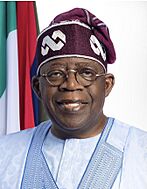Head of state facts for kids
The head of state of a country is its highest leader. Think of them as the main representative of their nation. They might not always have the most power, but they are the face of the country, especially during important ceremonies and when meeting leaders from other nations.
- Emmanuel Macron, President of France
- Droupadi Murmu, President of India
- Joe Biden, President of the United States
- Yoon Suk-yeol, President of South Korea
- Charles III, King of the United Kingdom
- Luiz Inácio Lula da Silva, President of Brazil
- Bola Tinubu, President of Nigeria
- Halimah Yacob, President of Singapore
- Vladimir Putin, President of Russia
Contents
Who Can Be a Head of State?
There are different types of heads of state, depending on how a country is run.
Presidents in Republics
In a modern republic, the head of state is usually a president. Presidents are often elected by the people. Sometimes, they are chosen by a parliament, which is a group of elected officials. For example, the President of the United States is the head of state.
Kings and Queens in Monarchies
In a monarchy, the head of state is a king or queen. This role is usually inherited, meaning it passes down through a family. For example, Charles III is the King of the United Kingdom.
Other Unique Leaders
Some countries have special leaders as their head of state. For instance, the head of state of the Vatican City is the Pope.
Power of the Head of State
The amount of power a head of state has can be very different from one country to another.
Heads of State with Limited Power
In many modern monarchies, the king or queen has very little real power. Their job is more about representing the country and performing national ceremonies. The most powerful person in these countries is usually the head of government. This person is often the leader of the political party that wins the most votes in an election. The king or queen must follow the advice of the head of government. The United Kingdom is an example of this system, where the Prime Minister leads the government.
Heads of State with More Power
Sometimes, the president is the most powerful person in the country. This is true in the United States, where the president makes many important decisions.
However, in some republics, there might be both a president and a head of government. In these cases, the president acts a lot like a king or queen in a monarchy, focusing on ceremonial duties. The real decisions are left to the head of government. The Republic of Ireland uses this system.
Heads of State with Absolute Power
In older times, and in a few modern countries, the head of state has absolute power. This means they can make all decisions without needing approval from anyone else.
Images for kids
-
Grassalkovich Palace in Bratislava is the seat of the President of Slovakia.
-
Elizabeth II was the reigning monarch and head of state of the United Kingdom and 14 other countries.
-
Charles de Gaulle, President and head of state of the French Fifth Republic (1959–1969).
-
George Washington, the first president of the United States, helped set the example for how a head of state works in a republic.
-
George V, Emperor of India, and Empress Mary at the Delhi Durbar, 1911.
-
Tekiso Hati, ambassador of the Kingdom of Lesotho, presenting his credentials to Russian president Vladimir Putin.
-
Daniel B. Shapiro, U.S. ambassador to Israel, presents his credentials to Israeli president Shimon Peres on 3 August 2011.
-
A 1992 Letter of Credence, written in French, for the Czechoslovakian Ambassador to Lithuania, signed by the President of Czechoslovakia and addressed to his Lithuanian counterpart.
-
Albert II, King of the Belgians inspecting troops on Belgium's national day in 2011.
-
Nicolas Sarkozy, President of France and General Jean-Louis Georgelin, Chief of the Defence Staff, reviewing troops during the 2008 Bastille Day military parade on the Champs-Élysées in Paris.
-
Francis, from March 2013 the sovereign of the Vatican City State, an ex officio role of the Pope.
-
Abdulmecid II is the 150th and last Caliph of Islam from Ottoman dynasty.
-
Four generations of Danish kings in 1903: King Christian IX (left), Christian (X) (back), Frederick (VIII) (right), and Frederick (IX) (front).
-
The National Monument to Emperor Wilhelm I in Berlin, Germany, dedicated 1897. It was destroyed in 1950.
-
Frontispiece of Thomas Hobbes' Leviathan (1651).
See also
 In Spanish: Jefe de Estado para niños
In Spanish: Jefe de Estado para niños





























